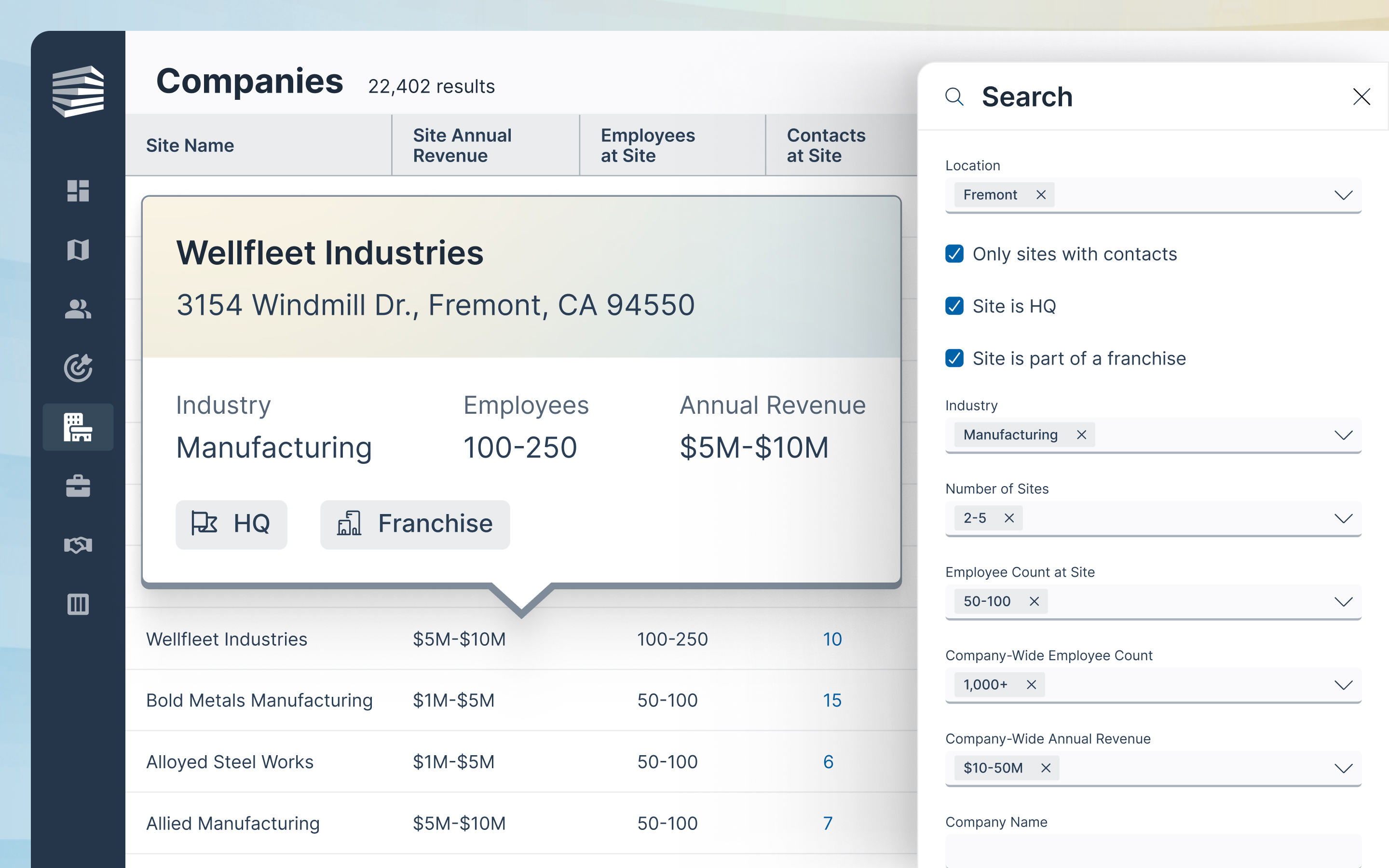Introduction
Commercial cleaning and janitorial needs are everywhere, so why does it feel so hard to get a contract? Competition, workforce shortages, employee reliability, odd working hours, and competitor price gouging are definitely part of the problem, but the other may be something you haven’t considered.
Many cleaning businesses find themselves spending valuable time trying to find decision-makers through outdated methods which are expensive, waste time, and lead to chasing the wrong leads.
There’s no doubt today’s market for services is fast-paced—and successful companies are overcoming this challenge with data.
I know the topic of “data” seems invasive, vague, and confusing at times, but it’s helping commercial services companies streamline their prospecting, focus on high-value properties, and ultimately close more deals.
So today, we’re going to make it simple.
In this guide, we’ll explore practical, data-backed strategies to help you find and win more commercial cleaning contracts. These steps are designed to reduce the time spent searching for prospects, enabling you to focus on building relationships and growing your client base.
Whether you’re a sales rep or a business owner, these tips will help you compete more effectively in your market.
The Challenge: Finding Local Leads and Securing Commercial Cleaning Contracts

Salespeople in commercial cleaning face a series of daunting obstacles if they don’t have the right tools. Finding quality leads, getting around gatekeepers, talking directly to decision-makers, and leaving a lasting impression in a noisy crowded market.
Traditional prospecting methods like “driving for dollars,” canvassing, dropping in, or using LinkedIn to search for decision-makers may produce results, but they often require significant time and effort.
Why Traditional Prospecting Methods Are Limiting: Relying solely on outdated methods can lead to missed opportunities, as you may overlook properties with immediate needs.
Defining and Targeting Your Ideal Clients

The best long-term cleaning contracts often come from banks, stores, data centers, schools, offices, gyms, government buildings, and mixed-use facilities. These types of buildings are high-traffic, demand consistent cleaning standards, and present excellent opportunities for long-term, recurring contracts.
Before we get into the tools to find decision-makers at these facilities, let’s talk about why it’s important to define your ideal customer profile (ICP) and target market.
For starters, using one building type to create your ICP—this could be owner-occupied office buildings or schools—allows you to focus on one property type to narrow down your search. Using private schools as our example, a well-defined ICP then enables you to understand the organizational structure and value you provide. Schools have a lot in common, from their hours of operation to the types of facilities that need cleaning and the level of cleaning and sanitation they require.
They also share a similar set of requirements, similar facilities managers, and procurement processes. Identifying these common attributes will help you target your efforts and allocate resources more efficiently.
In short:
Identify Target Clients: Start by identifying the types of properties that align with your services, whether it’s janitorial, deep cleaning, or maintenance for high-traffic areas.
Segment the Market: Break down your potential clients into segments, such as healthcare facilities or apartment complexes, and focus your outreach on one area at a time.
Define who makes decisions for that property: This is usually the facilities manager, office manager, or could even be a property owner. Knowing who has decision-making power will help you tailor your message and approach.
Using this approach will let you create a list of buildings that meet your criteria and filter out low-value prospects. This focus helps you save time and concentrate your efforts on clients who genuinely need your services.
Building a Targeted Prospect List with Property and Ownership Data

Finding the right decision-makers at commercial properties can be a challenge. This is especially true when you’re faced with layers of gatekeepers or hard-to-find contact information. But, property owners and managers are the ones who allocate the budget for services and most often have the final say on these contracts.
Traditionally, this is where you’d use Google Maps, driving for dollars, or canvassing to find the properties that match your ideal type locally. But as we’ve discussed, this is inefficient and ineffective.
Tools like Convex’s property intelligence work similarly to Google Maps and include all of the data for almost 6 million commercial properties in the US in a simple map interface. This allows you to narrow down all of the property types that fit your services in your territory and focus on those, but it also goes one step further—with built-in buying signals, Convex will actually show you which accounts are actively searching for commercial cleaning and janitorial services, and which ones aren’t. You can further filter these results by property type, size, and location for a more targeted list.

Once you’ve narrowed down your search, you can access detailed information on each property, including ownership data. This allows you to identify the decision-makers at each property based on their role or title, making it easier to reach out directly to those who have the power to award contracts, which we’ll discuss in depth in the next section.
This equips your team to:
Access Key Property Insights: Look for data that tells you more about a building’s specific needs, like total area and maintenance history.
Find Decision-Makers Quickly: By targeting property managers, facility directors, and owners, you reach those who can make or influence purchasing decisions.
Actively see who’s in the market, removing the guesswork.
Reducing Research Time and Targeting the Right Prospects: Platforms like Convex that consolidate property and contact data into one central interface can dramatically cut down the time it takes to find relevant leads. Instead of spending hours researching, you can focus on connecting with prospects and setting up meetings.
Timing Your Outreach for Maximum Impact

High-quality outreach blends two key factors:
1. Relevance (Reaching out at the right moment)
2. Personalization
Getting the timing right is a game-changer. Decision-makers who don’t need cleaning will find your messages irrelevant, and you’ll probably receive messages like, “No thanks,” “Not interested,” or “We already have a cleaning service.” But if you reach out with valuable information tailored to their needs at the right time, you’ll get a much better response.
Many commercial cleaning contracts are won or lost based on reaching out at the right moment, such as when a property is doing a build-out, has a new occupant, or is undergoing renovations. This is the power of permit data and buyer intent signals.
There are two ways to find permit history—search the country assessor’s records (this department goes by different names depending on your state and city)—or use property intelligence.
Identify Signals of Buyer Intent: Look for signs that a property may be in need of cleaning services, such as a recent permit for renovations or an upcoming maintenance window.
Use Permit Data to Spot Opportunities: Permit data can indicate whether a building will need post-construction or move-in cleaning, long-term cleaning and janitorial services, and other custom solutions.
Act on Expiring Lease Contracts, Construction Dates, and other Maintenance Cycles: Properties often have cyclical cleaning needs or contracts that expire on a regular schedule. By tracking these cycles, you can plan your outreach around upcoming openings, increasing your chances of securing contracts.
Personalizing Your Outreach and Sales Proposal with Unique Property Insights

Next, personalize. Have you ever received a generic sales email? They’re almost robotic. When it’s time to pitch your services, generic outreach, and standard proposals won’t make you stand out. Using personalized sales methods will.
Here are two examples:
Generic Sales Email:
Hi [First Name],
I hope you’re well. We specialize in commercial cleaning services and offer thorough, reliable solutions for facilities like yours. Our team handles everything from routine janitorial tasks to deep cleaning, ensuring your property always looks its best.
Let me know if you’d be interested in learning more about how we can support your property’s cleaning needs.
Best,
[Your Name]
[Your Company Name]
[Your Contact Information]
Compare that to something like this:
Tailored Sales Email:
Hi [First Name],
I noticed that [Property Name] recently went through some renovations, and I wanted to reach out with some tailored cleaning options that could help prepare your facility for its next tenant.
With [Property’s usage] and high traffic, I know how critical it is for your team to maintain a clean, spotless environment.
Our services are designed specifically for properties in the medical space that require consistent quality and high standards, especially in [specific areas if known, e.g., lobbies, stairwells, or bathrooms].
Our team has helped similar facilities, such as [Case Study/Example Property], improve overall cleanliness and reduce tenant complaints, leading to greater satisfaction and retention.
I’d be happy to schedule a brief call or even a short visit to [Property Name] to discuss how we can create a custom cleaning plan that ensures your property always looks its best.
Are you open to chatting for 10 minutes next week?
Looking forward to connecting,
[Your Name]
[Your Company Name]
[Your Contact Information]
Which one do you think you’d rather receive if you were looking for a commercial cleaner?
Property insights like the ones Convex delivers allow you to customize your outreach, highlighting specific areas of need and solutions for each client.
Use Data-Driven Insights to Customize Proposals: Include property details, such as high-traffic zones, that show you understand the client’s unique needs.
Create a Compelling Value Proposition: Differentiate your service by showing how you can address specific challenges they face, show that you’ve helped similar property types and ensure the lead that you can meet their cleanliness standards for their facilities.
Showcase Your Experience with Case Studies: Include relevant examples from similar clients or industries to build credibility and demonstrate your effectiveness.
Accelerating Outreach with Generative AI and Automation

Using Generative AI for outreach is very different from using ChatGPT. As I alluded to earlier, Convex’s Generative AI factors in all of the property intelligence data, sales intelligence insights (data on the account and contacts), and buying signals, as well as information on your business and the sales reps’ contact information before drafting emails or scripts for phone calls and Loom videos.
This allows you to skip the long research processes and make personalization effortless so you can focus on building relationships and closing deals. AI tools like Convex can help draft personalized messages quickly, and set up automated reminders that handle follow-up tasks seamlessly.
Personalize Outreach: AI can help create tailored emails or call scripts that are specific to each prospect, making your communication more impactful.
Add a Human Touch: For high-value prospects, try creating a short video message that addresses their specific needs. Studies show that personalized video outreach can increase engagement rates significantly.
Building a Sustainable Sales Pipeline with Prospecting, CRM, and Sales Workflow Tools

Creating a strong sales pipeline is key to sustained growth, especially when you’re juggling accounts across an entire territory. With Convex, all of your prospects, leads, and sales opportunities are in one place- giving you visibility into your entire marketplace. This begins with lead generation tools like buying signals and intent data, but also includes CRM and workflow tools that make it easier to manage and follow up on leads systematically.
Organize Leads and Track Progress: Use Convex’s CRM and Kanban boards to keep your pipeline organized so you know exactly where each lead is in the sales cycle.
Set Reminders for Follow-Ups: Automate reminders and follow-ups to ensure no opportunity slips through the cracks.
Map Territories for Strategic Outreach: Territory-based prospecting lets you plan sales routes and manage outreach efforts more efficiently within specific regions.
Before we get into the metrics of tracking and improving sales performance, what we’ve covered thus far is the blueprint for effectively finding and closing deals. If you empower your team with a few key tools, high-quality data, and insights on what the decision-makers are actively trying to find, you’ll have built an effective sales engine that accelerates revenue.
But there is always room for improvement – after all, even Michael Jordan (the Greatest Basketball Player of all time) needed a coach.
Metrics to Track and Improve Sales Performance

To continuously improve, it’s important to measure your sales performance and the performance of your team. How can you improve? Deliver higher quality experiences? and Win more Deals?
Tracking metrics like sales per channel, lead conversion rates, response times, and sales cycle length can help you identify areas for improvement.
Monitor Key Sales Metrics: Measure every step of your sales cycle. Track lead generation, conversion rates, deal size, and response times to assess the effectiveness of your approach.
Refine Your Strategy with Data: Use performance data to adjust your approach based on what works best for your business. I’ve found that the best place to look for opportunities is closed/lost deals in the pipeline or potential customers with an unusually long sales cycle. This will uncover areas for improvement that you can implement into team training in the future.
Invest in Continuous Learning: Staying updated on tips, tactics, tricks, industry trends and new prospecting techniques can give you a competitive edge over time- just don’t get complacent. When sales gets complacent the competition can easily creep in and take market share from right under your nose.
Conclusion

Winning commercial cleaning contracts requires more than just traditional prospecting methods; it calls for strategic, data-driven approaches that can help you target the right properties and decision-makers more efficiently.
By combining data insights, timely outreach, and automation, you’ll spend less time searching and more time connecting with the people who need your services.
If you’re ready to streamline your sales process, Schedule a free demo of Convex to see how the right tools and insights can open up new opportunities for building lasting relationships (and contracts) across the industry.
Share





